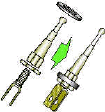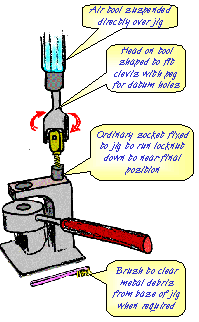


|
Easy Working Example |
| 'Easy Working' is one of those glib
expressions that often roll off peoples' tongues - 'Work Smarter, Not
Harder' is another. What on earth do they mean? With GK we aim to
consistently deliver the the right quantity and quality of product, to the
right place, on time. Furthermore, we must do this safely, and with the
minimum effort. Maximum Out for Minimum In!
This example illustrates how even small problems can be complex and make effective management more difficult. An assembly cell could not meet deliveries. Station 1 had a difficult job and was off-line to allow for build up of buffer stock, yet there were shortfalls. Customers were unhappy; the production team frustrated at stop~start working; the operator on Station 1 was physically isolated and had an awkward job &and managers were pulling their hair out! A small team representing production and maintenance studied the cell. Jobs were timed in order to highlight variation and to enforce close scrutiny. They decided to focus on the first station were the job was to assemble a rod, locknut and sponge washer to a threaded clevis. The length of the assembly was critical to +/- 0.15mm and assured by the use of a jig. |
 |
|
Not only was station 1 cycle time longer, it was also inconsistent. Genbutsu (the real thing) was difficult to assemble. |  |
| What sort of countermeasures were considered? A design change was recommended - but these normally take weeks or months to implement. Plating too is someone else's genba - although a better standard was required. The only aspect over which the team had complete control was the method. | 1) Feed back to platers? 2) Mechanise nut running? 3) Revise method? 4) Incorporate lead into thread? |
| The method
had to be easy; consistently achieve a tight specification despite some
variable materials; be safe; and be consistently achievable within the 30
second tact (customer cycle time)
There were no 'right' answers. The PDCA cycle was followed in evaluating several ideas before one was selected. It achieved the required criteria, was practical, and could be implemented quickly using available equipment and the skills of team members. |
 |
Tools and jigs were designed to
allow:
|
 |
|
|
The results were:
|
|
Although targets had
been met, further improvements carried out after this project included:
|
| This example only covers one aspect of easy working. There are many others which consider not only optimising methods and ergonomics, but ensuring that people are cross-trained so that they can rotate and avoid RSI-associated risks, minimising down-time required for maintenance or changeovers, minimising time spent on material handling, etc. | ||
|
GENBA KANRI: The web site dedicated to improving manufacturing competitiveness |
|
|
genba-kanri.com |